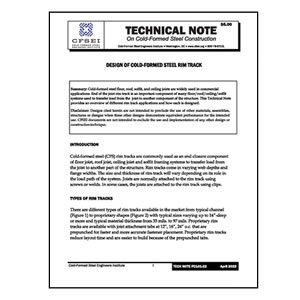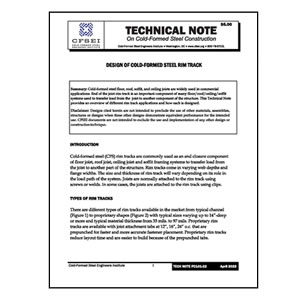Tech Note J100-23: Cold-Formed Steel Floor Joist Design
$5.00
This Tech Note Updates and Replaces Tech Note J100-11
Summary: Cold-formed steel (CFS) joists have become very popular where non-combustible material and long unsupported spans are required in design. The purpose of this Tech Note is to provide a review and summary of the AISI S240, North American Standard for Cold-Formed Steel Structural Framing and S100, North American Specification for the Design of Cold-Formed Steel Structural Members design requirements for cold-formed steel floor joists.
Disclaimer: Designs cited herein are not intended to preclude the use of other materials, assemblies, structures or designs when these other designs demonstrate equivalent performance for the intended use. CFSEI documents are not intended to exclude the use and implementation of any other design or construction technique.
Related Products

Tech Note B009-20: Structural Versus Nonstructural Cold-Formed Steel Framing
Summary: This Tech Note defines structural and non-structural cold-formed steel framing. It lists code definitions that can be used to categorize framing in question.
Disclaimer: Designs cited herein are not intended to preclude the use of other materials, assemblies, structures or designs when these other designs demonstrate equivalent performance for the intended use. CFSEI documents are not intended to exclude the use and implementation of any other design or construction technique.

Tech Note B004-20: Introduction to Cold-Formed Steel Framing Standards
Summary: The AISI Committee on Framing Standards was established in 1998 with a mission to eliminate regulatory barriers and increase the reliability and cost competitiveness of cold-formed steel framing in residential and light commercial building construction through improved design and installation standards. This Tech Note summarizes the efforts and work products of the Committee.
Disclaimer: Designs cited herein are not intended to preclude the use of other materials, assemblies, structures or designs when these other designs demonstrate equivalent performance for the intended use. CFSEI documents are not intended to exclude the use and implementation of any other design or construction technique.

Tech Note B010-21: Introduction to AISI S202, Code of Standard Practice for Cold-Formed Steel Structural Framing
Summary: Understanding the responsibilities of the different parties involved in a cold-formed steel framing project can be confusing. This Technical Note is an introduction to AISI S202, Code of Standard Practice for Cold-Formed Steel Structural Framing published by the American Iron and Steel Institute (AISI).
Disclaimer: Designs cited herein are not intended to preclude the use of other materials, assemblies, structures or designs when these other designs demonstrate equivalent performance for the intended use. CFSEI documents are not intended to exclude the use and implementation of any other design or construction technique.

Tech Note FC101-22: Design of Cold-Formed Steel Rim Track
Summary: Cold-formed steel floor, roof, soffit, and ceiling joists are widely used in commercial applications. End of the joist rim track is an important component of many floor/roof/ceiling/soffit systems used to transfer load from the joist to another component of the structure. This Technical Note provides an overview of different rim track applications and how each is designed.
Disclaimer: Designs cited herein are not intended to preclude the use of other materials, assemblies, structures or designs when these other designs demonstrate equivalent performance for the intended use. CFSEI documents are not intended to exclude the use and implementation of any other design or construction technique.

Tech Note S300-21: Coordinating Cold-Formed with Metal Buildings
Summary: This Technical Note presents a discussion of both the design responsibilities and the need for coordination when integrating field-framed, i.e., stick-built, cold-formed steel (CFS) framing with a metal building system. Important potential coordination topics connection details and design concepts are highlighted.
Disclaimer: Designs cited herein are not intended to preclude the use of other materials, assemblies, structures or designs when these other designs demonstrate equivalent performance for the intended use. CFSEI documents are not intended to exclude the use and implementation of any other design or construction technique.

Tech Note F501-11: Cold-Formed Steel Truss To Bearing Connections
Summary: This Technical Note is intended as general educational information and to highlight what the building designer should be aware of with regard to truss to bearing connections. Topics addressed include what loads due to wind truss to bearing connections may have to resist, who is ultimately responsible for truss to bearing connection design, general guidance on the design of truss to bearing connections, and an illustrative design example. Loads due to seismic forces are not addressed in this Technical Note.
Disclaimer: Designs cited herein are not intended to preclude the use of other materials, assemblies, structures or designs when these other designs demonstrate equivalent performance for the intended use. CFSEI documents are not intended to exclude the use and implementation of any other design or construction technique.

Tech Note G105-22: Compression Member Reinforcement
Summary: To modify the capacity of a compression member, e.g. wall stud or truss web, adding a reinforcement may result in a non-prismatic member. This Tech Note provides guidance to evaluate the strength of a non-prismatic compression member.
Disclaimer: Designs cited herein are not intended to preclude the use of other materials, assemblies, structures or designs when these other designs demonstrate equivalent performance for the intended use. CFSEI documents are not intended to exclude the use and implementation of any other design or construction technique.

Tech Note 562-22: Powder-Actuated Fasteners in Cold-Formed Steel Construction
This Technical Note updates and replaces Tech Note 562
Summary: Power-actuated fasteners (PAF’s) are industry standard for attachment of cold-formed steel (CFS) steel framing members, usually track, to concrete, CMU or steel structural elements. “Power-actuated” is the broad category used to refer to fasteners which are driven directly through the CFS and into the substrate, using a powder, gas, compressed air or electro-mechanically driven tool. Efficient installation of framing systems is greatly enhanced by the use of PAF’s. For CFS-to-steel applications, the specification AISI S100 addresses all relevant limit states with equations and safety/ resistance factors. For CFS-to-concrete, limited guidance is provided but not all limit states are covered. This technical note will provide design guidance based on AISI S100, as well as installation and good detailing practice.
Disclaimer: Designs cited herein are not intended to preclude the use of other materials, assemblies, structures or designs when these other designs demonstrate equivalent performance for the intended use. CFSEI documents are not intended to exclude the use and implementation of any other design or construction technique.

